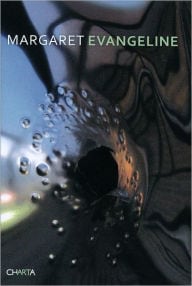
Hailing from Louisiana and now a resident New Yorker, Margaret Evangeline isn’t afraid to tackle an array of difficult subjects using “aesthetically resistant” materials. Her first monograph, Margaret Evangeline: Shooting Through the Looking Glass, demonstrates the breadth of her work and the various influences that inspired it. To create Gunshot Landscape, perhaps her most talked about work, she shot stainless steel panels with a rifle in New Mexico and then hung them in the forest in upstate New York (she also set them afloat in the River Thames and inside galleries and homes). She believes that the stainless steel surfaces “resemble extensive space (as opposed to deep space)” and that “the bullet hole opens on to deep space.” Indeed, the effect is startling: the forest is reflected, obscured, and somehow amplified by the punctured mirror. Evangeline saw Gunshot Landscape as cathartic art at a time when she most needed it—at an artist-in-residency program that housed New York artists after 9/11. Such expository details make Margaret Evangeline: Shooting Through the Looking Glass an insightful look into her life and work.
Other notable works by Evangeline include eXile, a video of a woman in stilettos stomping on bullet cases, and a site-specific, abandoned New Orleans shack that she painted blue, wrote “(AMERICA)” in a bold yellow across the front, and filled with river dirt from the 7th Ward. The stimuli that spark her colorful abstract works range from the Japanese tradition of mending porcelain to a Marie Tussaud wax figure of Madame du Barry, the mistress of Louis XV. As Edward Lucie-Smith writes in the introduction, “[Evangeline’s] work is essentially a continuous flow of associations and ideas. It combines great matters and small ones.” It also involves physical and conceptual play and a lawless—I can do anything—attitude from the artist. The conversation between Evangeline and art critic Dominique Nahas takes the reader further into Evangeline’s mind and personality—how her works revolve around her sense of place and her need to be close to a river. Such nuances are picked up throughout the book and reveal an artist deeply attuned to what’s around her, unafraid to use a variety of mediums. She puts it best when she says, “It’s all about what the body knows, not just logic. And that’s a point of view of mine, more like an act of faith.”
Written by Josh Parkey